Development of an Underground Tunnels Detection Algorithm for Electrical Resistivity Tomography Based on Deep Learning
Abstract
:Featured Application
Abstract
1. Introduction
2. Research Method
2.1. Electrical Resistivity Tomography (ERT)
2.2. Reliability Analysis
2.3. Deep Learning
- Input layer: the number of neurons of the input layer is determined by the point k of input data.
- Hidden layer: fully connected layer between the input layer and output layer.
- Output layer: the neuron of the output layer is determined by the number of classes or the output of the approximation function.
3. Results and Discussion
3.1. ERT Field Acquisition and Data Analysis
3.1.1. L1 Survey Line
3.1.2. L2 Survey Line
3.1.3. L3 Survey Line
3.1.4. Comprehensive Interpretation
3.2. Reliability Analysis
4. Deep Learning Prediction
5. Conclusions
Author Contributions
Funding
Institutional Review Board Statement
Informed Consent Statement
Data Availability Statement
Conflicts of Interest
References
- Chiang, B.W. Investigation and Research of Kinmen Wars Records; Kinmen National Park: Kinmen, Taiwan, 2005. [Google Scholar]
- The Underground Tunnels Collapsed and Endangered the Houses, Kinmen Daily. 2014. Available online: https://www.chinatimes.com/realtimenews/20140523003816-260402?chdtv (accessed on 30 October 2021).
- The Government Public Works Were Stopped Construction by Underground Tunnels during Excavation, Liberty Times. 2018. Available online: https://www.kmdn.gov.tw/1117/1271/1272/136247/ (accessed on 30 October 2021).
- The Government Public Works Were Found Ammunition Galleries during Excavation, Kinmen Daily. 2006. Available online: https://www.kmdn.gov.tw/1117/1271/1272/136098/?cprint=pt (accessed on 30 October 2021).
- Raffaele Persico Salvatore Piro Neil Linford, Innovation in Near Surface Geophysics; Elsevier: Amsterdam, The Netherlands, 2018; ISBN 9780128124307.
- Lin, C.P.; Lin, C.H.; Wu, P.L.; Liu, H.C.; Hung, Y.C. Applications and challenges of near surface geophysicals in geotechnical engineering. Chin. J. Geophys. 2015, 58, 2664–2680. [Google Scholar]
- Lin, C.H.; Lin, C.P.; Hung, Y.C.; Chung, C.C.; Wu, P.L.; Liu, H.C. Application of geophysical methods in a dam project: Life cycle perspective and Taiwan experience. J. Appl. Geophys. 2018, 158, 82–92. [Google Scholar] [CrossRef]
- Stokoe, K.H.; Joh, S.H.; Woods, R.D. Some contribution of in situ geophysical measurements to solving geotechnical engineering problems. In Proceedings of the 2nd International Geotechnical and Geophysical Site Characterization Conference, ISC-2, Porto, Portugal, 19–22 September 2004; pp. 97–132. [Google Scholar]
- Geophysical Survey System, Inc. Traning Notes; GSSI Press: Nashua, NH, USA, 1992. [Google Scholar]
- Geophysical Survey System, Inc. RADAN for Windows Version 5.0 User’s Manual; GSSI Press: Nashua, NH, USA, 2003; pp. 1–132. [Google Scholar]
- Ribolini, A.; Bini, M.; Isola, I.; Coschino, F.; Baroni, C.; Salvatore, M.C.; Zanchetta, G.; Fornaciati, A. GPR versus geoarchaeological findings in a complex archaeological site (Badia Pozzeveri, Italy). Archaeol. Prospect. 2017, 24, 141–156. [Google Scholar] [CrossRef]
- Lee, D.H.; Lai, S.L.; Wu, J.H.; Chang, S.K.; Dong, Y.M. Detecting the remaining structure foundation using ground penetrating radar: The outer wall of small east gate of Taiwan FU, Taiwan. J. GeoEng. 2018, 13, 85–92. [Google Scholar] [CrossRef]
- Baryshnikov, V.D.; Khmelin, A.P.; Denisova, E.V. GPR detection of inhomogeneities in concrete lining of underground tunnels. J. Min. Sci. 2014, 50, 25–32. [Google Scholar] [CrossRef]
- Li, S.C.; Zhou, Z.Q.; Ye, Z.H.; Li, L.P.; Zhang, Q.Q.; Xu, Z.H. Comprehensive geophysical prediction and treatment measures of karst caves in deep buried tunnel. J. Appl. Geophys. 2015, 116, 247–257. [Google Scholar] [CrossRef]
- Mochales, T.; Casas, A.M.; Pueyo, E.L.; Pueyo, O.; Román, M.T.; Pocoví, A.; Soriano, M.A.; Ansón, D. Detection of underground cavities by combining gravity, magnetic and ground penetrating radar surveys: A case study from the Zaragoza area, NE Spain. Environ. Geol. 2008, 53, 1067–1077. [Google Scholar] [CrossRef]
- Karlovsek, J.; Scheuermann, A.; Willimas, D.J. Investigation of voids and cavities in bored tunnels using GPR. In Proceedings of the 2012 14th International Conference on Ground Penetrating Radar (GPR), Shanghai, China, 4–8 June 2012; pp. 496–501. [Google Scholar]
- Gracia, V.P.; Canas, J.A.; Pujades, L.G.; Clapés, J.; Caselles, O.; Garcıa, F.; Osorio, R. GPR survey to confirm the location of ancient structures under the Valencian Cathedral (Spain). J. Appl. Geophys. 2000, 43, 167–174. [Google Scholar] [CrossRef]
- Leucci, G.; Parise, M.; Sammarco, M.; Scardozzi, G. The Use of Geophysical Prospections to Map Ancient Hydraulic Works: The Triglio Underground Aqueduct (Apulia, Southern Italy): GPR and ERT Survey on Ancient Hydraulic Works. Archaeol. Prospect. 2016, 23, 195–211. [Google Scholar] [CrossRef]
- Dahlin, T. The development of DC resistivity imaging techniques. Comput. Geosci. 2001, 27, 1019–1029. [Google Scholar] [CrossRef] [Green Version]
- Hung, Y.C.; Chou, H.S.; Lin, C.P. Appraisal of the Spatial Resolution of 2D Electrical Resistivity Tomography for Geotechnical Investigation. Appl. Sci. 2020, 10, 4394. [Google Scholar] [CrossRef]
- Suzuki, K.; Toda, S.; Kusunoki, K.; Fujimitsu, Y.; Mogi, T.; Jomori, A. Case studies of electrical and electromagnetic methods applied to mapping active faults beneath the thick quaternary. Eng. Geol. 2000, 56, 29–45. [Google Scholar] [CrossRef]
- Demanet, D.; Renardy, F.; Vanneste, K.; Jongmans, D.; Camelbeeck, T.; Meghraoui, M. The use of geophysical prospecting for imaging active faults in the Roer Graben, Belgium. Geophysics 2001, 66, 78–89. [Google Scholar] [CrossRef]
- Batayneh, A.; Barjous, M. A Case Study of Dipole-Dipole Resistivity for Geotechnical Engineering from the Ras en Naqab Area, South Jordan. J. Environ. Eng. Geophys. 2003, 8, 31–38. [Google Scholar] [CrossRef]
- Rizzoa, E.; Colellab, A.; Lapennaa, V.; Piscitellia, S. High resolution images of the fault controlled High Agri Valley basin (Southern Italy) with deep and shallow electrical resistivity tomographies. Phys. Chem. Earth 2004, 29, 321–327. [Google Scholar] [CrossRef]
- Nguyen, F.; Garambois, S.; Jongmans, D.; Pirard, E.; Loke, M.H. Image processing of 2D resistivity data for imaging faults. J. Appl. Geophys. 2005, 57, 260–277. [Google Scholar] [CrossRef]
- Pazzi, V.; Morelli, S.; Fanti, R. A Review of the Advantages and Limitations of Geophysical Investigations in Landslide Studies. Int. J. Geophys. 2019, 2019, 2983087. [Google Scholar] [CrossRef] [Green Version]
- Batayneh, A.; Al-Diabat, A.A. Application of a two dimensional electrical tomography technique for investigating landslides along the Amman–Dead Sea highway, Jordan. Environ. Geol. 2002, 42, 399–403. [Google Scholar] [CrossRef]
- Perrone, A.; Iannuzzi, A.; Lapenna, V.; Lorenzo, P.; Piscitelli, S.; Rizzo, E.; Sdao, F. High resolution electrical imaging of the Varco d’Izzo earthflow (southern Italy). J. Appl. Geophys. 2004, 56, 17–29. [Google Scholar] [CrossRef]
- Chen, T.T.; Hung, Y.C.; Hsueh, M.W.; Yeh, Y.H.; Weng, K.W. Evaluating the Application of Electrical Resistivity Tomography for Investigating Seawater Intrusion. Electronics 2018, 7, 107. [Google Scholar] [CrossRef] [Green Version]
- Nyquist, J.E.; Bradley, J.C.; Davis, R.K. DC resistivity monitoring of potassium permanganate injected to oxidize TCE in situ. J. Environ. Eng. Geophys. 1999, 4, 135–148. [Google Scholar] [CrossRef]
- Lin, C.-P.; Hung, Y.-C.; Yu, Z.-H. Performance of 2D ERT in Investigation of Abnormal Seepage: A Case Study at the Hsin-Shan Earth Dam in Taiwan. J. Environ. Eng. Geophys. 2014, 9, 101–112. [Google Scholar] [CrossRef]
- Hung, Y.C.; Chen, T.T.; Tsai, T.F.; Chen, H.X. A Comprehensive Investigation on Abnormal Impoundment of Reservoirs—A Case Study of Qionglin Reservoir in Kinmen Island. Water 2021, 13, 1463. [Google Scholar] [CrossRef]
- Colucci, P.; Darilek, G.T.; Laine, D.L.; Binley, A. Locating Landfill Leaks Covered with Waste. In Proceedings of the International Waste Management and Landfill Symposium, Sardinia 99, Cagliari, Italy, 4–8 October 1999; Volume 3, pp. 137–140. [Google Scholar]
- Binley, A.; Daily, W.; Ramirez, A. Detecting leaks from waste storage ponds using electrical tomographic methods. In Proceedings of the 1st World Congress on Process Tomography, Buxton, UK, 14 April 1999; pp. 6–17. [Google Scholar]
- Daily, W.; Ramirez, A.; Binley, A. Remote Monitoring of Leaks in Storage Tanks using Electrical Resistance Tomography: Application at the Hanford Site. J. Environ. Eng. Geophys. 2004, 9, 11–24. [Google Scholar] [CrossRef]
- Orfanos, C.; Apostolopoulos, G. 2D-3D resistivity and microgravity measurements for the detection of an ancient tunnel in the Lavrion area, Greece. Near Surf. Geophys. 2011, 9, 449–457. [Google Scholar] [CrossRef]
- Mousavi, H.; Khazaei, S. Detection of underground tunnels using electrical resistivity and refraction seismic tomography methods. J. Earth Space Phys. 2016, 42, 578–606. [Google Scholar]
- Lesparre, N.; Boyle, A.; Grychtol, B.; Cabrera, J.; Marteau, J.; Adler, A. Electrical resistivity imaging in transmission between surface and underground tunnel for fault characterization. J. Appl. Geophys. 2016, 128, 163–178. [Google Scholar] [CrossRef]
- Loke, M.H. Tutorial: 2-D and 3-D Electrical Imaging Surveys; Geotomo Software: Penang, Malaysia, 2004. [Google Scholar]
- Pouyanfar, S.; Sadiq, S.; Yan, Y.; Tian, H.; Tao, Y.; Reyes, M.P.; Shyu, M.L.; Chen, S.C.; Iyengar, S.S. A survey on deep learning: Algorithms, techniques, and applications. ACM Comput. Surv. (CSUR) 2018, 51, 1–36. [Google Scholar] [CrossRef]
- Alile, O.M.; Aigbogun, C.O.; Enoma, N.; Abraham, E.M.; Ighodalo, J.E. 2D and 3D Electrical Resistivity Tomography (ERT) Investigation of Mineral Deposits in Amahor, Edo State, Nigeria. Niger. Res. J. Eng. Environ. Sci. 2017, 2, 215–231. [Google Scholar]
- Alile, O.M.; Abraham, E.M. Three dimensional geoelectrical imaging of the subsurface structure of university of Benin-Edo state Nigeria. Adv. Appl. Sci. Res. 2015, 6, 85–93. [Google Scholar]
- Bentley, L.R.; Gharibi, M. Resistivity Imaging at a Heterogeneous Two and Three Dimensional Electrical Remediation Site. Geophysics 2004, 69, 674–680. [Google Scholar] [CrossRef]
- Chávez, R.E.; Cifuentes Nava, G.; Tejero, A.; Hernández Quintero, J.E.; Vargas, D. Special 3D electric resistivity tomography (ERT) array applied to detect buried fractures on urban areas: San Antonio Tecómitl, Milpa Alta, México. Geofísica Int. 2014, 53, 425–434. [Google Scholar] [CrossRef] [Green Version]
- Osinowo, O.O.; Falufosi, M.O. 3D Electrical Resistivity Imaging (ERI) for subsurface evaluation in pre engineering construction site investigation. NRIAG J. Astron. Geophys. 2018, 7, 309–317. [Google Scholar] [CrossRef]
- Geotomo Software 2002. RES2DMOD Ver. 3.01, Rapid 2D Resistivity forward Modelling Using the Finite Difference and Finite-Element Methods. Available online: https://www.geotomosoft.com/index.php (accessed on 30 October 2021).
- Geotomo Software 2007. RES2DINV Ver. 3.56, Rapid 2D Resistivity and IP Inversion Using the Least Squares Method. Available online: https://www.geotomosoft.com/index.php (accessed on 30 October 2021).
- Russell, S.; Norvig, P. Artificial Intelligence: A Modern Approach. 2002. Available online: https://storage.googleapis.com/pub-tools-public-publication-data/pdf/27702.pdf (accessed on 30 October 2021).
- Rojas, R. Neural Networks: A Systematic Introduction; Springer Science & Business Media: Berlin/Heidelberg, Germany, 2013. [Google Scholar]
- Nilsson, N.J. Principles of Artificial Intelligence; Morgan Kaufmann: Burlington, MA, USA, 2014. [Google Scholar]
- LeCun, Y.; Bengio, Y.; Hinton, G. Deep learning. Nature 2015, 521, 436–444. [Google Scholar] [CrossRef] [PubMed]
- Goodfellow, I.; Bengio, Y.; Courville, A. Deep Learning; MIT Press: Cambridge, MA, USA, 2016. [Google Scholar]
- Kingma, D.P.; Ba, J.L. Adam: A Method for Stochastic Optimization. In Proceedings of the International Conference on Learning Representations, San Diego, CA, USA, 7–9 May 2015; pp. 1–13. [Google Scholar]
- Heusel, M.; Ramsauer, H.; Unterthiner, T.; Nessler, B.; Hochreiter, S. GANs Trained by a Two Time Scale Update Rule Converge to a Local Nash Equilibrium. Adv. Neural Inf. Processing Syst. 2017, 30, 1–12. [Google Scholar]
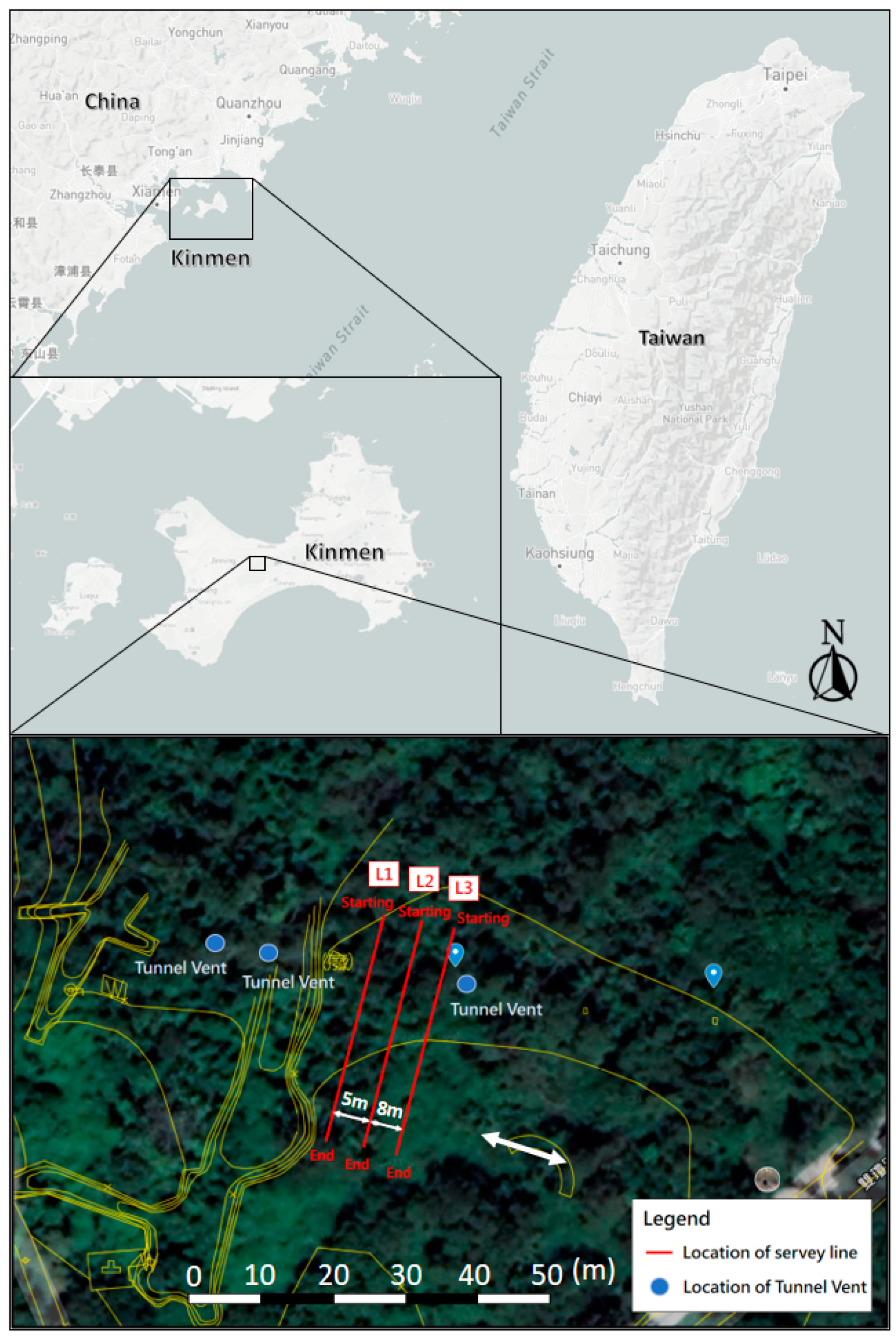
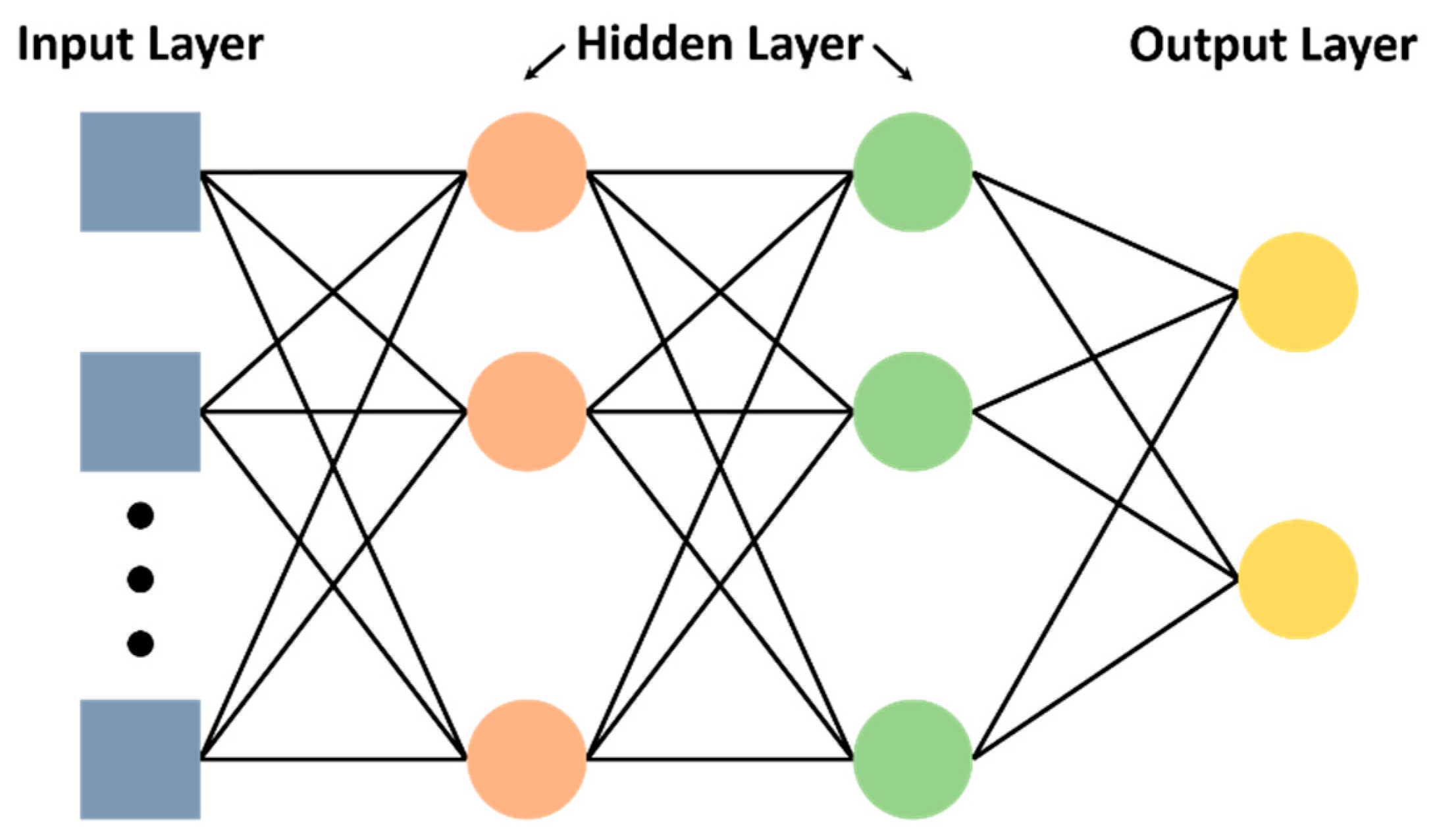



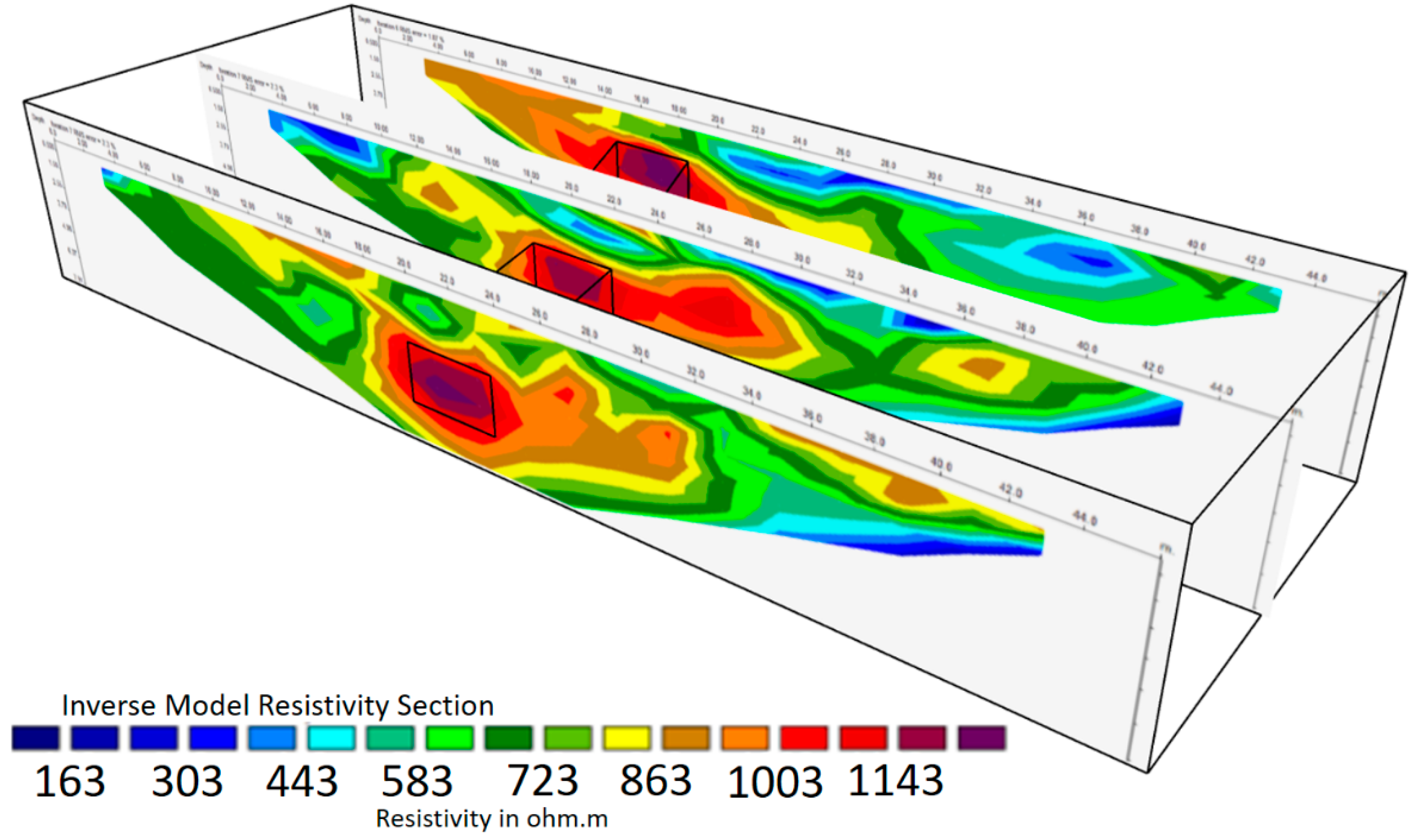
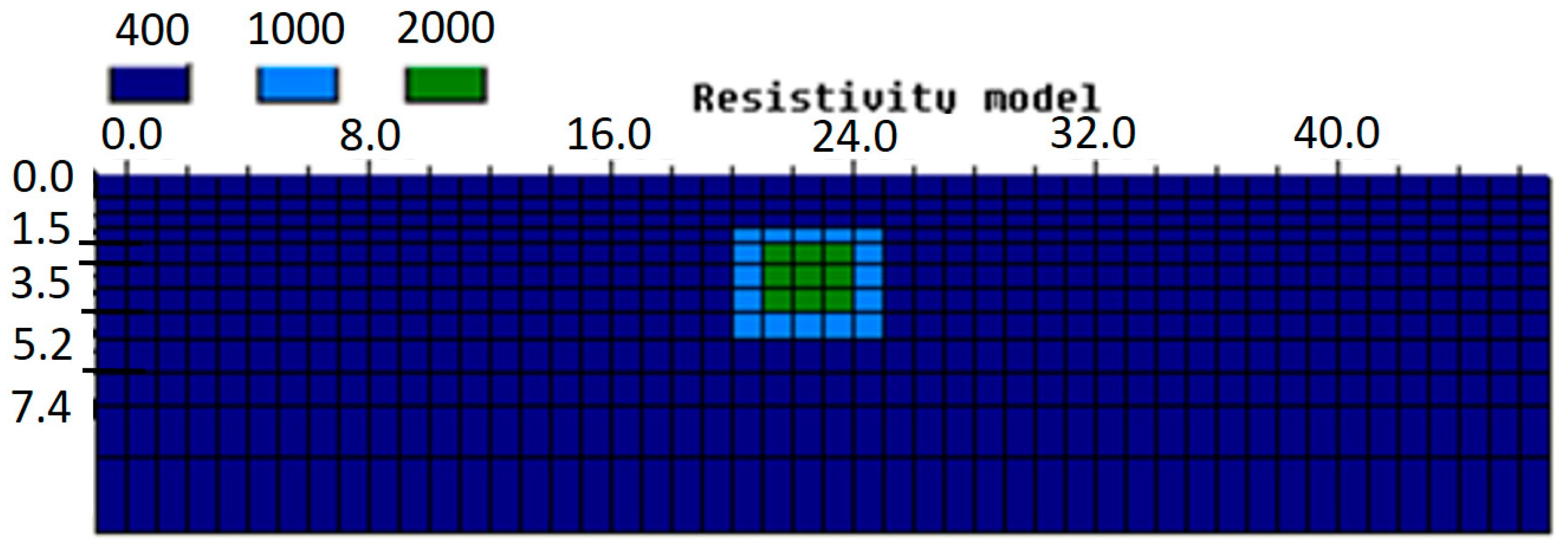

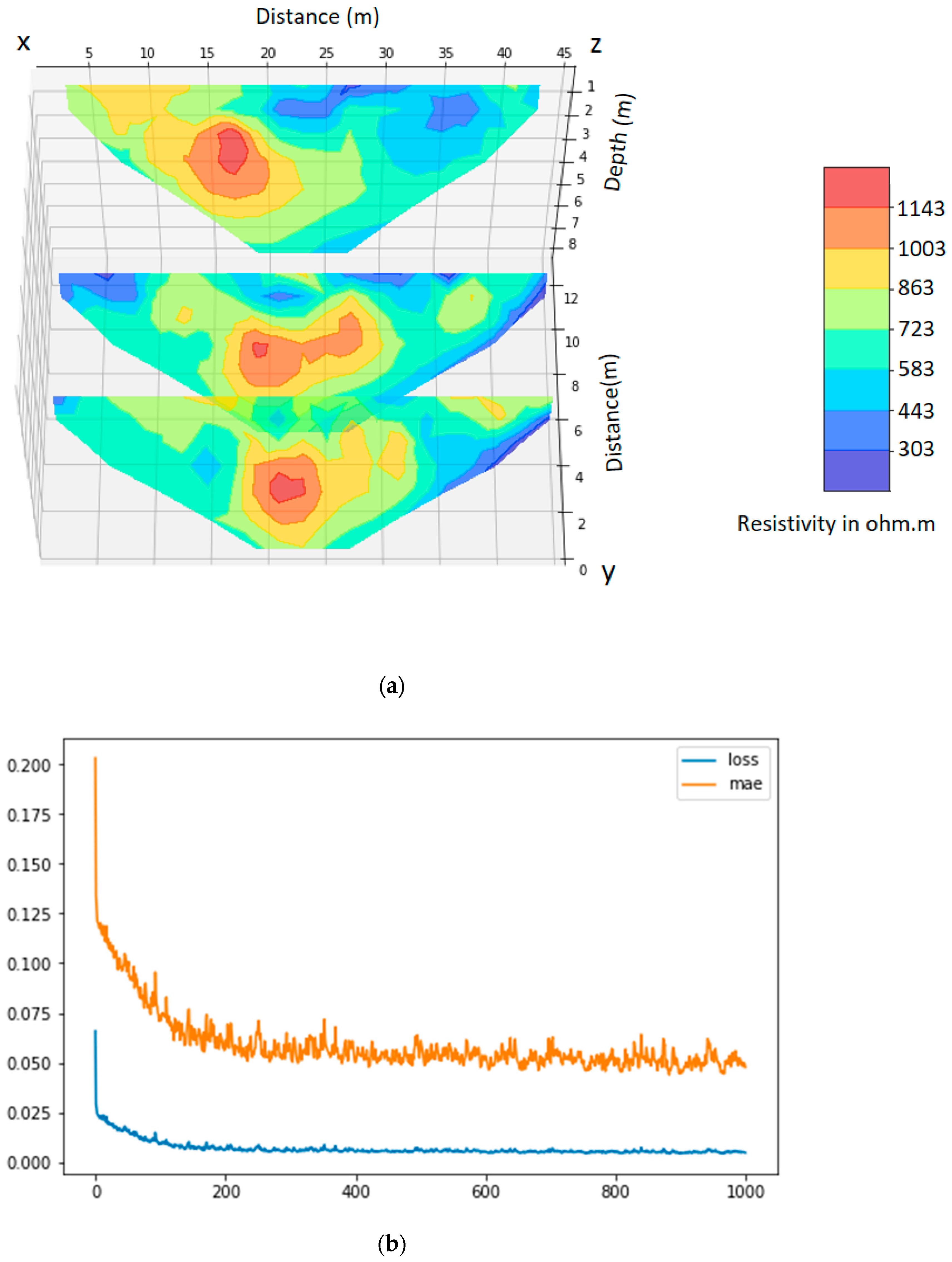

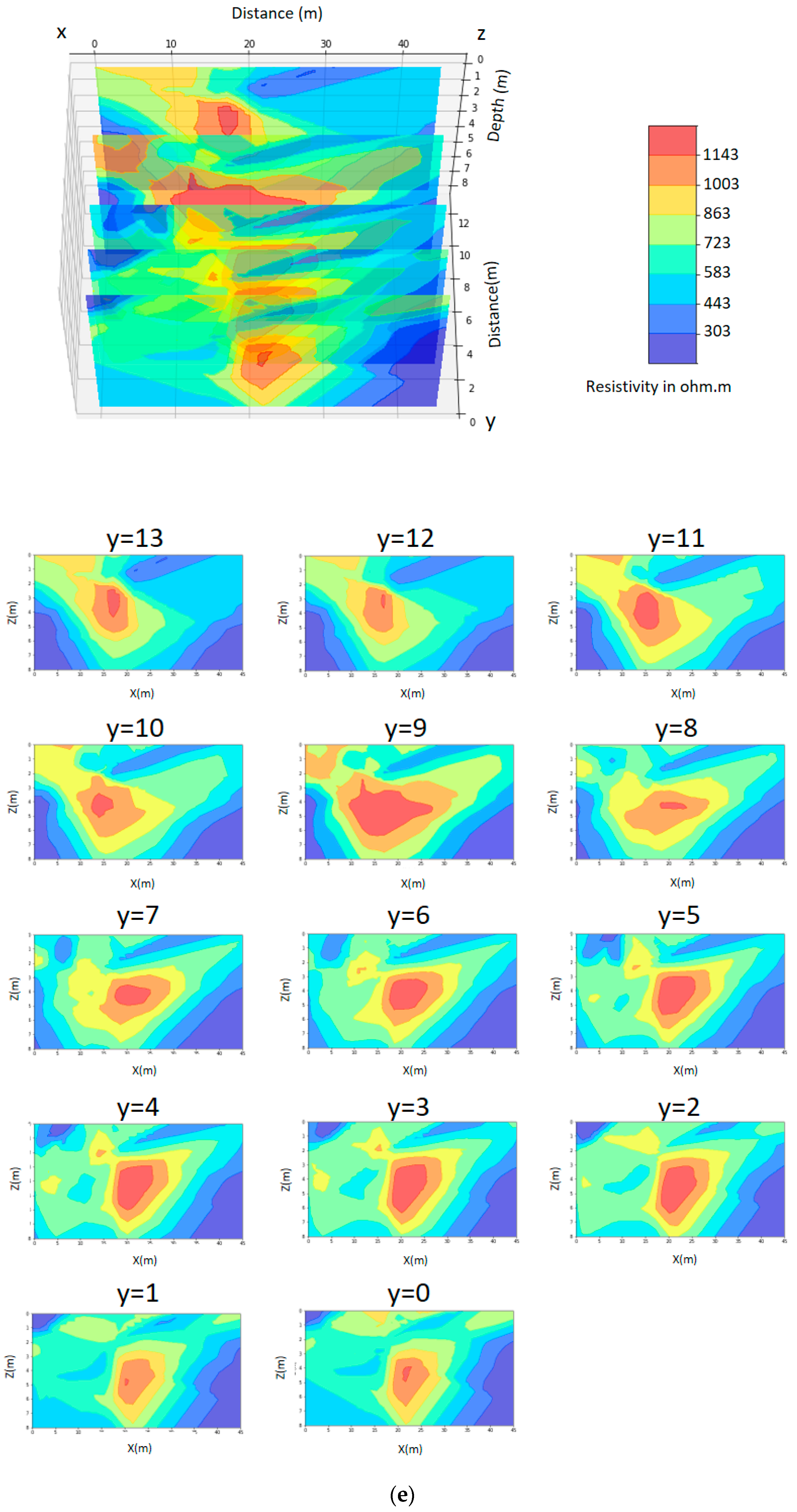
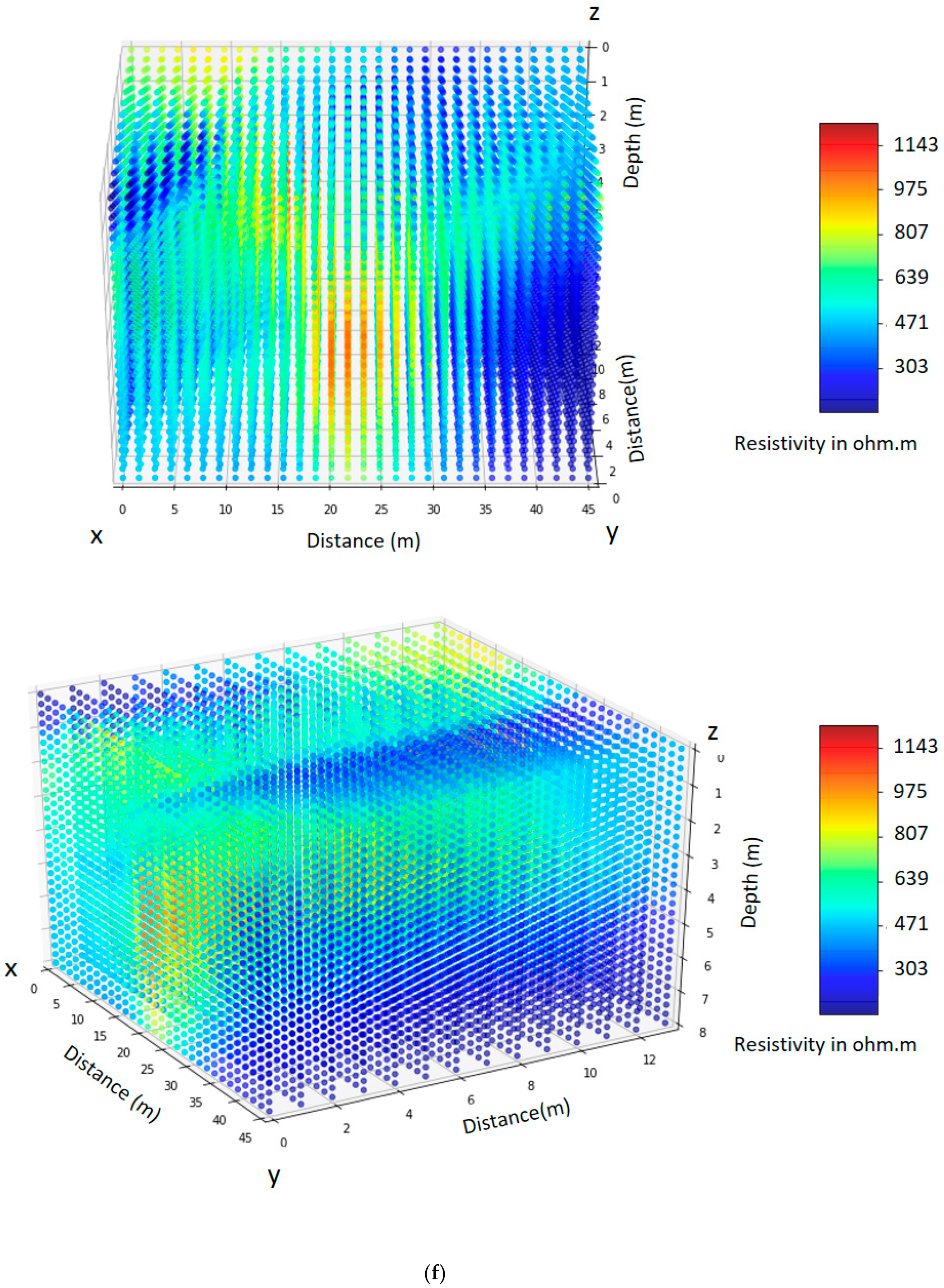

| Structure | Parameter |
|---|---|
| Number of layers | 3 |
| Number of Neurons in the layers | Input = 2, Hidden1 = 32, Hidden2 = 32 Output = 1 |
| Initial weights and biases | Random |
| Activation function | Sigmoid |
| Optimization | Adam |
Publisher’s Note: MDPI stays neutral with regard to jurisdictional claims in published maps and institutional affiliations. |
© 2022 by the authors. Licensee MDPI, Basel, Switzerland. This article is an open access article distributed under the terms and conditions of the Creative Commons Attribution (CC BY) license (https://creativecommons.org/licenses/by/4.0/).
Share and Cite
Hung, Y.-C.; Zhao, Y.-X.; Hung, W.-C. Development of an Underground Tunnels Detection Algorithm for Electrical Resistivity Tomography Based on Deep Learning. Appl. Sci. 2022, 12, 639. https://doi.org/10.3390/app12020639
Hung Y-C, Zhao Y-X, Hung W-C. Development of an Underground Tunnels Detection Algorithm for Electrical Resistivity Tomography Based on Deep Learning. Applied Sciences. 2022; 12(2):639. https://doi.org/10.3390/app12020639
Chicago/Turabian StyleHung, Yin-Chun, Yu-Xiang Zhao, and Wei-Chen Hung. 2022. "Development of an Underground Tunnels Detection Algorithm for Electrical Resistivity Tomography Based on Deep Learning" Applied Sciences 12, no. 2: 639. https://doi.org/10.3390/app12020639






